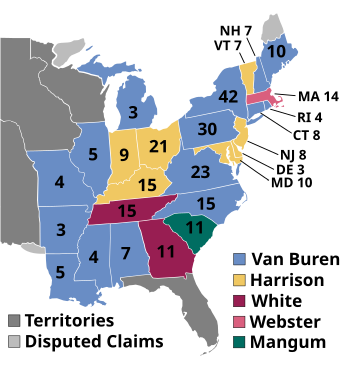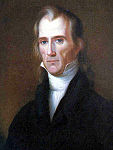U.S. presidential election, 1836
|
|
|||||||||||||||||||||||||||||||||||||||||||||||||||||||||||||||||||||
|---|---|---|---|---|---|---|---|---|---|---|---|---|---|---|---|---|---|---|---|---|---|---|---|---|---|---|---|---|---|---|---|---|---|---|---|---|---|---|---|---|---|---|---|---|---|---|---|---|---|---|---|---|---|---|---|---|---|---|---|---|---|---|---|---|---|---|---|---|---|
|
|||||||||||||||||||||||||||||||||||||||||||||||||||||||||||||||||||||
|
All 294 electoral votes of the Electoral College 148 electoral votes needed to win |
|||||||||||||||||||||||||||||||||||||||||||||||||||||||||||||||||||||
| Turnout | 57.8% |
||||||||||||||||||||||||||||||||||||||||||||||||||||||||||||||||||||
|
|||||||||||||||||||||||||||||||||||||||||||||||||||||||||||||||||||||

Presidential election results map. Blue denotes states won by Van Buren and Johnson or Smith, pale grey-purple denotes those won by Harrison and Granger or Tyler, purple denotes those won by White/Tyler, coral pink denotes those won by Webster/Granger, and bluegrass green denotes those won by Mangum/Tyler. Numbers indicate the number of electoral votes allotted to each state.
|
|||||||||||||||||||||||||||||||||||||||||||||||||||||||||||||||||||||
|
|||||||||||||||||||||||||||||||||||||||||||||||||||||||||||||||||||||
The United States presidential election of 1836 was the 13th quadrennial presidential election, held from Thursday, November 3, to Wednesday, December 7, 1836. As the third consecutive election victory for the Democratic Party, it ushered incumbent Vice President Martin Van Buren into the White House with 170 electoral votes to 124 electoral votes for William Henry Harrison and other Whigs. The popular vote was closer; Martin Van Buren attracted 764,000 votes to the 738,000 won by the various Whig candidates.
The election of 1836 is principally remembered for three distinctive circumstances:
The election of 1836 also marked an important turning point in American political history because of the part it played in establishing the Second Party System. In the 1830s the political party structure was still changing, rapidly, the Democratic Party was organized, but factional and personal leaders still played a major role in politics. By the end of the campaign of 1836, the new party system was almost complete, as nearly every faction had been absorbed by either the Democrats or the Whigs.
Incumbent President Andrew Jackson decided to retire after two terms and supported his vice-president, Martin Van Buren, to serve as the next president. Although Southerners disliked the New Yorker Van Buren as well as his intended running mate, Colonel Richard M. Johnson of Kentucky, Van Buren secured the nomination at the 1835 Democratic National Convention held in Baltimore, Maryland.
...
Wikipedia





